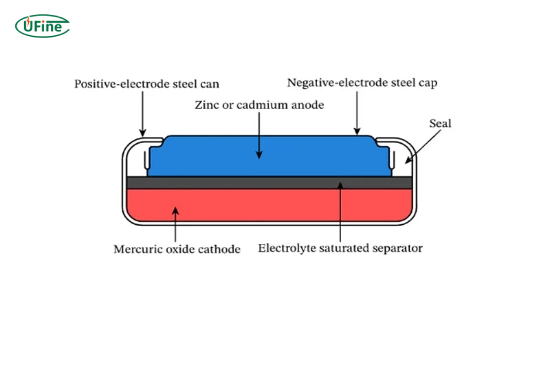
- Part 1. What is a disk battery?
- Part 2. How does a disk battery generate power?
- Part 3. What types of disk batteries are available?
- Part 4. What devices use disk batteries?
- Part 5. How do you choose the right disk battery?
- Part 6. Can disk batteries be recharged?
- Part 7. How long do disk batteries last?
- Part 8. How should disk batteries be stored?
- Part 9. How to dispose of disk batteries safely?
- Part 10. What are the signs that a disk battery needs replacement?
- Part 11. FAQs about disk batteries
A disk battery is a small, round power source used in many everyday electronic devices. These compact cells, found in watches, calculators, hearing aids, and remote controls, provide a reliable energy supply for devices that require low but consistent power. This guide explores disk batteries, their work, and why they are essential in modern electronics.
Part 1. What is a disk battery?
A disk battery is a compact, circular battery that resembles a coin in size and shape. It is also commonly referred to as a button cell or coin cell. Disk batteries are typically used in small, portable electronic devices that require minimal power over long periods. They are known for their long shelf life and stability, making them ideal for devices that need to operate reliably without frequent battery changes.
These batteries come in various sizes and chemical compositions, each suited for different applications. Their small size allows them to fit into tight spaces where traditional batteries are impractical.
Part 2. How does a disk battery generate power?
Disk batteries generate electrical energy through an internal chemical reaction. Each battery has two terminals: a positive terminal (cathode) and a negative terminal (anode). When the battery is connected to a device, the chemical compounds inside the cell react to produce a flow of electrons from the negative to the positive terminal. This flow of electrons generates electricity that powers the device.
The battery’s chemical composition determines its voltage, capacity, and overall performance. Some common chemicals used in disk batteries include lithium, silver oxide, and alkaline compounds.
Part 3. What types of disk batteries are available?
Disk batteries come in several types, each offering different characteristics. Understanding the differences between these types can help users choose the right battery for their device.
Silver Oxide (SR series)
- Provides a stable voltage throughout its life
- High energy density
- Common in watches, medical devices, and precision instruments
Alkaline (LR series)
- Lower cost compared to silver oxide
- Shorter lifespan
- Used in toys, small flashlights, and inexpensive electronics
Lithium (CR series)
- High energy density
- Long shelf life, often over 10 years
- Frequently used in key fobs, glucometers, and security devices
- Used mainly in hearing aids
- Activated by exposure to air
- Lightweight with high energy output for its size
Each battery type is identified by a code printed on its surface, which includes information about its size and chemistry. For example, a CR2032 battery has a 20-mm-diameter lithium cell that is 3.2mm thick.
Part 4. What devices use disk batteries?
Disk batteries are used in various devices that require compact power sources. Some of the most common applications include:
- Wristwatches
- Hearing aids
- Calculators
- Medical thermometers
- Fitness trackers
- Digital timers
- Electronic car keys
- Small flashlights
- Remote controls
- Blood glucose monitors
Their small form factor and long-lasting energy output make them ideal for any product where space and battery replacement frequency are critical considerations.
Part 5. How do you choose the right disk battery?
Selecting the correct disk battery involves checking the physical size, voltage, and chemical type. The easiest way to identify the right battery is to refer to the code printed on the old battery or consult the device’s manual.
Important factors to consider include:
- Size: Measured in diameter and thickness
- Voltage: Usually 1.5V, 3V, or 1.55V depending on the chemistry
- Capacity: Affects how long the battery lasts
- Operating temperature range: Some devices may require batteries that work in extreme temperatures
Using the wrong battery can result in poor performance or even damage to the device.
Part 6. Can disk batteries be recharged?
Most disk batteries are non-rechargeable. They are designed for single use and must be replaced once their energy is depleted. Attempting to recharge a non-rechargeable disk battery can be dangerous and may result in leakage, overheating, or explosion.
However, a few rechargeable variants, such as lithium-ion button cells, are used in specific applications like smartwatches and small wearable devices. These rechargeable models are labeled differently and require compatible charging systems.
Part 7. How long do disk batteries last?
The lifespan of a disk battery depends on several factors:
- Battery chemistry
- Device power consumption
- Storage conditions
- Environmental temperature
On average, a disk battery can last between 1 and 5 years. For example:
- A silver oxide battery in a wristwatch may last up to 3 years
- A zinc-air battery in a hearing aid might last only 5 to 14 days due to constant use
- A lithium coin cell in a key fob could last 4 to 6 years
Proper storage and minimal usage can extend the shelf life of unused batteries beyond 10 years, especially for lithium types.
Part 8. How should disk batteries be stored?
Proper storage helps maintain battery performance and safety. Follow these tips:
- Keep batteries in a cool, dry place
- Avoid direct sunlight and high temperatures
- Store batteries in their original packaging or a non-metallic container
- Keep away from other batteries to prevent accidental discharge
Never store loose batteries in a drawer with metal objects, which can lead to short-circuiting.
Part 9. How to dispose of disk batteries safely?
Disk batteries contain mercury, lithium, and other heavy metals that can be harmful if improperly handled. Disposing them in regular trash can lead to environmental pollution and health hazards.
To dispose of disk batteries:
- Take them to a local recycling center
- Use battery collection programs offered by electronics stores
- Contact your municipal waste authority for proper disposal instructions
Never burn or incinerate batteries, as this can release toxic fumes.
Part 10. What are the signs that a disk battery needs replacement?
Devices powered by disk batteries often show clear signs when the battery is losing charge. Look out for the following:
- The device stops working or turns off unexpectedly
- The screen fades or becomes hard to read
- Buttons become unresponsive
- A low battery warning appears (on digital devices)
- Inconsistent performance or frequent resets
Replacing the battery as soon as these symptoms appear can prevent device malfunction or damage.
Part 11. FAQs about disk batteries
What is the difference between CR and LR disk batteries?
CR batteries are lithium-based and offer a higher voltage and longer lifespan. LR batteries are alkaline-based, cheaper, but typically offer a shorter life and are more prone to voltage drops over time.
Can disk batteries leak?
Yes, alkaline disk batteries can leak if left in devices for too long after being drained. Leaking can damage the device’s internal components. Silver oxide and lithium batteries are less prone to leakage but require proper handling.
Are disk batteries interchangeable?
Not always. Batteries with similar sizes may still have different voltages or chemical compositions. Always check the battery code and your device’s compatibility before replacing it.
What should I do if a disk battery is swallowed?
Swallowing a disk battery is a medical emergency. It can cause severe internal burns within hours. Seek immediate medical attention. Do not induce vomiting or give anything by mouth unless instructed by a medical professional.
Can disk batteries explode?
While rare, disk batteries can explode if they are overheated, short-circuited, or mishandled. Store and dispose of them properly to prevent accidents.
Related Tags:
More Articles

A Complete Guide to the Best Batteries for Flashlights
Discover the best batteries for flashlights: alkaline, lithium, NiMH & rechargeable options. Tips for performance and maintenance.
Graphene Battery vs Lithium Battery: Which is Better?
Compare graphene battery vs lithium battery in energy density, charging speed, lifespan, cost, and EV applications. Learn which battery leads in 2025.
What is the Difference Between MCA and CCA on Batteries?
Learn the difference between MCA and CCA batteries. Understand what MCA means, what CCA is, and how to choose the right battery for vehicles or marine engines.
Type of Lithium Battery Voltage
Learn lithium ion battery voltage, nominal voltage, and voltage range. Compare Li-ion, LiPo, LiFePO4, and 18650 voltages, charging, and device compatibility.
Gel Battery vs Lead Acid: A Detailed Comparison
Compare gel and lead-acid batteries: lifespan, cost, charging, DoD, safety, and key use cases. Find the right battery for solar, marine, EV, UPS, and daily use.




